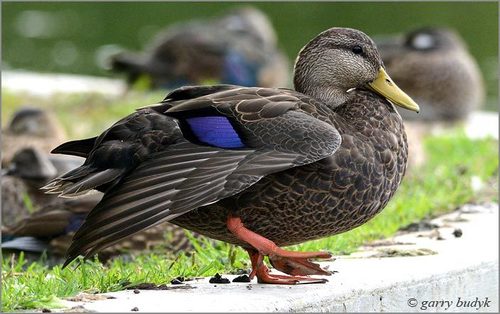
American Black Duck
The American Black Duck (*Anas rubripes*) is a large dabbling duck native to eastern North America. It is often mistaken for the female Mallard, but it is a distinct species with unique characteristics. Ecologically, it plays a role in seed dispersal and nutrient cycling within wetland ecosystems. Historically, it has been a significant game bird, and while populations have declined, it remains a subject of ongoing conservation efforts. Culturally, it features in some indigenous folklore and is recognized as an indicator species of wetland health.
53-61 cm
Length
88-96 cm
Wingspan
Least Concern
Conservation Status
Distribution
Primarily found in eastern North America, breeding from northeastern Canada south to the northeastern United States, and wintering as far south as the Gulf Coast and Florida. Some individuals may migrate shorter distances or remain resident in areas with open water year-round.
Lifespan
The oldest recorded American Black Duck was 26 years and 4 months old.
American Black Duck's Habitat
Habitat Types
Freshwater marshes, Salt marshes, Brackish estuaries, Lakes, Ponds, Rivers, Beaver ponds
Climate Zones
Temperate, Boreal
Adaptations
They are highly adaptable to various aquatic environments, utilizing both freshwater and saltwater habitats. Their dabbling feeding style allows them to access food in shallow waters.
Variations
No recognized subspecies, but some regional variations in plumage and size have been observed.
Appearance
Breeding Plumage
Plumage is similar year-round, although males may have brighter bills during the breeding season.
Seasonal Feather Changes
Minimal seasonal variation. Molting occurs after breeding, resulting in a temporary flightless period.
Sex Based Plumage Differences
Males and females have similar plumage, a dark sooty brown overall with a paler head and neck. The speculum (a patch on the wing) is iridescent violet-blue with black margins. Males have a yellow to olive-green bill, while females have a duller, olive-green to mottled brown bill.
Notable Features
Dark body plumage contrasting with a lighter head and neck., Violet-blue speculum on the wing., Orange to red legs and feet.
Diet and Feeding
Primary Foods
Seeds, Aquatic plants, Invertebrates, Small crustaceans, Mollusks, Insects
Foraging Behavior
Primarily dabbles, tipping headfirst into shallow water to reach submerged vegetation and invertebrates. Also grazes on land and occasionally dives.
Specializations
Their bill has lamellae (comb-like structures) that help filter small food items from the water.
Seasonal Diet Variations
Diet shifts seasonally depending on food availability. Invertebrates are more important during the breeding season for protein, while seeds and plant matter are dominant in winter.
Behavior
Social Structure
Forms pairs during the breeding season. Outside of breeding, they can be found in small flocks, sometimes larger aggregations during migration and winter.
Communication
A variety of quacks and whistles., Males have a softer, reedy call., Females have a loud, quacking call similar to a Mallard.
Migration
Many populations are migratory, moving south for the winter to areas with open water. Others are resident or only make short-distance movements.
Territorial or Group Behaviors
Males defend territories during the breeding season. Outside of breeding, they are generally less territorial and form flocks.
Conservation
Threats
Habitat loss and degradation, Hybridization with Mallards, Hunting pressure, Lead poisoning (from ingested lead shot), Climate change
Protection Programs
North American Waterfowl Management Plan, Wetland restoration and conservation initiatives, Hunting regulations
Local National Laws
Protected under the Migratory Bird Treaty Act in the United States and similar legislation in Canada.
Population Trend
Stable
Population Estimates
Estimated at around 670,000 breeding individuals.
Interesting Facts
They are known to hybridize with Mallards.
This hybridization can lead to genetic swamping and poses a threat to the genetic integrity of the American Black Duck.
They are one of the most wary and cautious ducks.
This makes them challenging to hunt and observe closely.
They often associate with other dabbling ducks.
They can be found in mixed flocks with species like Mallards and Gadwalls.
Faqs about American Black Duck
How can I tell an American Black Duck from a female Mallard?
American Black Ducks are darker overall than female Mallards, with a more pronounced contrast between the dark body and lighter head. The speculum of the Black Duck is violet-blue, while the Mallard's is blue with white borders. Black Duck males have a yellow bill, where Mallards have orange bills.
Where can I see American Black Ducks?
Look for them in wetlands, marshes, and along coastlines in eastern North America. Check local wildlife refuges and parks.
Are American Black Ducks endangered?
No, they are currently listed as Least Concern by the IUCN, although their populations have declined historically and face ongoing threats.
Copyright @ Nature Style Limited. All Rights Reserved.
 English
English